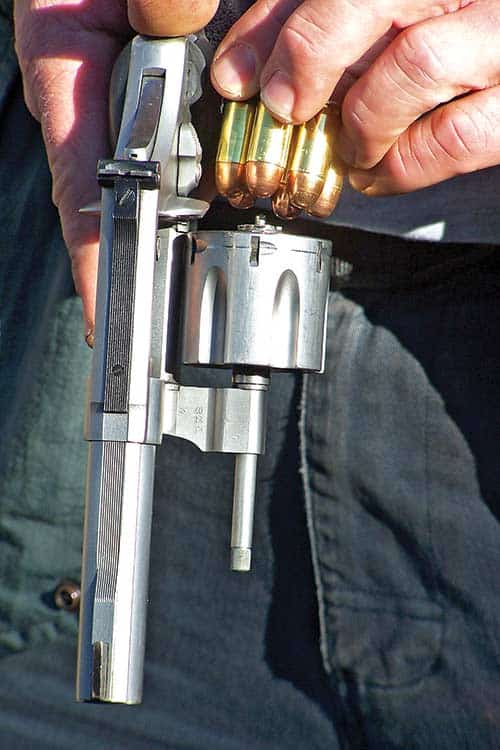IDPA ENHANCED SERVICE REVOLVERS
Moon-clip revolvers have a decisive
advantage over conventional DA sixguns
In past content, we’ve covered the three categories of semiauto pistols allowed in IDPA, the International Defensive Pistol Association. Until 2005, there was only one revolver category in this sport, Stock Service Revolver (SSR). It permitted wheel-guns of up to 4″-barrel length (up to 5″ for the first few years), with a power floor of 125,000 (bullet weight multiplied by velocity) and minimum caliber of .38 Special.
From the beginning in 1996, revolvers handling full-moon clips dominated competition. They were simply faster to reload than any kind of speedloader using standard rimmed cartridges. With a speedloader, one has to insert the six rounds, perform a pressing, turning or stripping movement to release the payload into the chambers, and then toss the empty loader aside or at least take an instant to let go of it before the cylinder could be closed.
With a full-moon clip, two of those movements were eliminated. Now it was just shove the whole thing in and close the cylinder. The self-contained unit went into the gun.
Distinct Advantage
There were other advantages. The revolver could be held with its barrel on-target during the operation with a “moon gun” because the shooter no longer had to worry about cartridge rims getting caught under the ejector star. With short, “rimless” auto pistol cartridges held together in the moon clip, that was physically impossible.
Since “moon guns” so thoroughly dominated SSR, to allow conventional revolvers to effectively compete, the two types were separated in April ’05. Now only revolvers firing conventional rimmed cartridges can shoot in StockService Revolver class.
So many IDPA shooters bought moon-clip revolvers those guns couldn’t just be banned. Instead, they got their own category: ESR, or Enhanced Service Revolver.
The most-winning revolver has been winning since IDPA began: the Smith & Wesson Model 625 in .45 ACP. Its big cartridge allows a soft reload to make the power floor easily, the equivalent of 9mm ball in power factor. A 230-grain round nose chugging along at a sloth-like 600 fps will do it easily. So will the notoriously soft-shooting .45 target load — the 185-grain Mid-Range Match. However, the roundnose is faster during reloading, and fast reloading was the reason moon guns took over revolver shooting in the first place.
Yes, there are other moon-clip revolvers available. There are 8-shooters in .38 Super and 7- and 8-shooters in .38 Special/.357 Magnum, but in IDPA they can only be loaded with six cartridges at any given time. This would require the shooter to risk a wasted click or two per run, or the shooter would need to take extra time to carefully index the cylinder before closing so an empty chamber didn’t come up. With an electronic timer running the whole time, that’s just not practical.
Five-shot moon-clip 9mms like S&W’s own late, lamented Model 942, the Ruger SP101 or the new little Taurus won’t cut it. IDPA is geared around sixshot sequences and a five-shot gun simply can’t compete effectively.
Other Moonies
I’d love to try Ruger’s old fixed-sight Service-Six and Speed-Six 9mms with their six-shot moon clips at this game, but haven’t been able to find one. Haven’t even seen one at an IDPA match. It’s something of a rara avis —highly prized by Ruger collectors.
Smith & Wesson has made two efforts to supplement their 625 in IDPA, but neither has been successful. One was the Model 610 revolver, chambered for 10mm (and, in every specimen I’m aware of, exquisitely accurate) but perfectly functional with milder .40 S&W ammo, which head spaced on the moon clips. Alas, few were made with 4″ barrels and, last I knew, isn’t made anymore at all. It also seemed slower to reload with smaller torpedoes going into smaller launch tubes.
S&W also offered the Model 646, an L-frame sixgun chambered for .40 S&W. It did not flourish and is no longer in the Smith & Wesson catalog. It was a sweet shooting revolver to be sure, but the 625 reloaded its big .45 slugs into large charge holes faster than the .40. And the .45 simply makes bigger holes, every now and then turning a close four-point hit into a barely-made it five-point score.
I carried a .45 ACP revolver on duty back in the early ’70s, and if I had to go back to a revolver for uniform wear today, the 625 would be my choice. It’s not a “cheat gun,” it’s an “efficiency gun.” Great “stopping power” with mild recoil, super-fast reloads and a short, size-efficient ammo package letting me squeeze four loaded moon clips into a Dade loader pouch designed for two Nframe
speedloaders.
This is not to say they can’t be beat. I watched Brent Purucker of S&W Academy win the Mid-Winter National Championships one year with a Model 13 Smith and Safariland speedloaders, beating every 625 in sight including (sob) mine. But such performances were the exception. The fact was, if all else was equal, the shooter with the moon-clip gun would beat the one with the speedloaders.
Which is why, in April of 2005, the Stock Service Revolver class was restricted to conventional six-shooters.

Get More Revolver Content Every Week!
Sign up for the Wheelgun Wednesday newsletter here:







